Vehicle Distance Measurement Method of Two-Way Two-Lane Roads Based on Monocular Vision
Abstract
1. Introduction
- The vehicle detection model suitable for two-way two-lane roads was trained.
- The influence of the roll angle of the camera on ranging results using the traditional geometric ranging method was analyzed. When the roll angle of the camera exists, the ranging result will deviate from the normal value. The degree of deviation will vary with the vehicle positions. Moreover, the larger the roll angle, the greater the deviation.
- The improved geometric ranging method considering the roll angle of the camera was proposed. Through experimental verification and method comparison, the proposed method is effective, and the improved geometric ranging method has higher ranging accuracy than the other two methods on two-way two-lane roads.
2. Methods
2.1. Establishment of Vehicle Detection Model of Two-Way Two-Lane Roads
2.1.1. Collection and Labeling of Data Set
2.1.2. Training of Vehicle Detection Model Using YOLOv5s Network
2.2. Establishment of Vehicle Distance Measurement Model
2.2.1. Imaging Principle of Monocular Vision
2.2.2. Calculation of Feature Point of Vehicle
2.2.3. Traditional Geometric Ranging Method
2.2.4. Improved Geometric Ranging Method
3. Experiments and Discussions
3.1. Training and Effect of Vehicle Detection Model of Two-Way Two-Lane Roads
3.2. Distance Measurement Experiment and Analysis of Results
4. Conclusions
Author Contributions
Funding
Institutional Review Board Statement
Informed Consent Statement
Data Availability Statement
Acknowledgments
Conflicts of Interest
References
- Chen, J.; Cai, B. Slot control optimization of intelligent platoon for dual-lane two-way overtaking behavior. J. Traffic Transp. Eng. 2019, 19, 178–190. [Google Scholar]
- Chen, J.; Bhat, M.; Jiang, S. Advanced driver assistance strategies for a single-vehicle overtaking a platoon on the two-lane two-way road. IEEE Access 2020, 8, 77285–77297. [Google Scholar] [CrossRef]
- Branzi, V.; Meocci, M.; Domenichini, L. A combined simulation approach to evaluate overtaking behaviour on two-lane two-way rural roads. J. Adv. Transp. 2021, 2021, 1–18. [Google Scholar] [CrossRef]
- Gray, R.; Regan, D.M. Perceptual processes used by drivers during overtaking in a driving simulator. Hum. Factors 2005, 47, 394–417. [Google Scholar] [CrossRef]
- Hegeman, G.; Tapani, A.; Hoogendoorn, S. Overtaking assistant assessment using traffic simulation. Transp. Res. Part C Emerg. Technol. 2009, 17, 617–630. [Google Scholar] [CrossRef]
- Jamson, S.; Chorlton, K.; Carsten, O. Could intelligent speed adaptation make overtaking unsafe? Accid. Anal. Prev. 2012, 48, 29–36. [Google Scholar] [CrossRef]
- Zhang, W.; Ma, J.; Ta, J. The identification of overtaking risk factors on two lane highways. For. Eng. 2017, 33, 89–93. [Google Scholar]
- Arabi, S.; Sharma, A.; Reyes, M. Farm Vehicle Following Distance Estimation Using Deep Learning and Monocular Camera Images. Sensors 2022, 22, 2736. [Google Scholar] [CrossRef]
- Qiao, D.; Zulkernine, F. Vision-based vehicle detection and distance estimation. In Proceedings of the 2020 IEEE Symposium Series on Computational Intelligence (SSCI), Canberra, ACT, Australia, 1–4 December 2020. [Google Scholar]
- Li, Q.; Huang, H.; Chu, P. The research of vehicle monocular ranging based on YOlOv5. In Proceedings of the 2022 4th International Conference on Industrial Artificial Intelligence (IAI), Shenyang, China, 24–27 August 2022. [Google Scholar]
- Shen, Z.; Huang, X. Monocular vision distance detection algorithm based on data regression modeling. Comput. Eng. Appl. 2007, 43, 15–17. [Google Scholar]
- Bao, D.; Wang, P. Vehicle distance detection based on monocular vision. In Proceedings of the 2016 International Conference on Progress in Informatics and Computing (PIC), Shanghai, China, 23–25 December 2016. [Google Scholar]
- Tuohy, S.; Diarmaid, O.C.; Jones, E. Distance determination for an automobile environment using inverse perspective mapping in OpenCV. In Proceedings of the IET Irish Signals and Systems Conference (ISSC 2010), Cork, Ireland, 23–24 June 2010. [Google Scholar]
- Adamshuk, R.; Carvalho, D.; Neme, J.H.Z. On the applicability of inverse perspective mapping for the forward distance estimation based on the HSV colormap. In Proceedings of the 2017 IEEE International Conference on Industrial Technology (ICIT), Toronto, ON, Canada, 22–25 March 2017. [Google Scholar]
- Ding, M.; Zhang, Z.; Jiang, X. Vision-based distance measurement in advanced driving assistance systems. Appl. Sci. 2020, 10, 7276. [Google Scholar] [CrossRef]
- Stein, G.P.; Mano, O.; Shashua, A. Vision-based ACC with a single camera: Bounds on range rate accuracy. In Proceedings of the IEEE IV2003 Intelligent Vehicles Symposium. Proceedings (Cat. No.03TH8683), Columbus, OH, USA, 9–11 June 2003. [Google Scholar]
- Liu, C.; Shuai, K.; Yang, W. Design of ranging system for embedded vision. J. Wuhan Univ. Technol. 2015, 37, 65–68. [Google Scholar]
- Rezaei, M.; Terauchi, M.; Klette, R. Robust vehicle detection and distance estimation under challenging lighting conditions. IEEE Trans. Intell. Transp. Syst. 2015, 16, 2723–2743. [Google Scholar] [CrossRef]
- Park, K.Y.; Hwang, S.Y. Robust range estimation with a monocular camera for vision-based forward collision warning system. Sci. World J. 2014, 2014, 923632. [Google Scholar] [CrossRef]
- Raza, M.; Chen, Z.; Rehman, S.U. Framework for estimating distance and dimension attributes of pedestrians in real-time environments using monocular camera. Neurocomputing 2018, 275, 533–545. [Google Scholar] [CrossRef]
- Kim, G.; Cho, J.S. Vision-based vehicle detection and inter-vehicle distance estimation. In Proceedings of the 2012 12th International Conference on Control, Automation and Systems, Jeju, Republic of Korea, 17–21 October 2012. [Google Scholar]
- Awasthi, A.; Singh, J.K.; Roh, S.H. Monocular vision-based distance estimation algorithm for pedestrian collision avoidance systems. In Proceedings of the 2014 5th International Conference—Confluence The Next Generation Information Technology Summit (Confluence), Noida, India, 25–26 September 2014. [Google Scholar]
- Ali, A.A.; Hussein, H.A. Distance estimation and vehicle position detection based on monocular camera. In Proceedings of the 2016 Al-Sadeq International Conference on Multidisciplinary in IT and Communication Science and Applications (AIC-MITCSA), Baghdad, Iraq, 9–10 May 2016. [Google Scholar]
- Zhang, Y.; Guo, Z.; Wu, J. Real-Time Vehicle Detection Based on Improved YOLOv5. Sustainability 2022, 14, 12274. [Google Scholar] [CrossRef]
- Dong, X.; Yan, S.; Duan, C. A lightweight vehicles detection network model based on YOLOv5. Eng. Appl. Artif. Intell. 2022, 113, 104914. [Google Scholar] [CrossRef]
- Carrasco, D.P.; Rashwan, H.A.; García, M.Á. T-YOLO: Tiny vehicle detection based on YOLO and multi-scale convolutional neural networks. IEEE Access 2021, 2021, 3137638. [Google Scholar] [CrossRef]
- Wu, T.; Wang, T.; Liu, Y. Real-time vehicle and distance detection based on improved yolo v5 network. In Proceedings of the 2021 3rd World Symposium on Artificial Intelligence (WSAI), Guangzhou, China, 18–20 June 2021. [Google Scholar]
- Song, X.; Gu, W. Multi-objective real-time vehicle detection method based on yolov5. In Proceedings of the 2021 International Symposium on Artificial Intelligence and its Application on Media (ISAIAM), Xi’an, China, 21–23 May 2021. [Google Scholar]
- Chen, Z.; Cao, L.; Wang, Q. Yolov5-based vehicle detection method for high-resolution UAV images. Mob. Inf. Syst. 2022, 2022, 1828848. [Google Scholar] [CrossRef]
- Huang, L.; Zhe, T.; Wu, J. Robust inter-vehicle distance estimation method based on monocular vision. IEEE Access 2019, 7, 46059–46070. [Google Scholar] [CrossRef]
- Zhang, Z. A flexible new technique for camera calibration. IEEE Trans. Pattern Anal. Mach. Intell. 2000, 22, 1330–1334. [Google Scholar] [CrossRef]

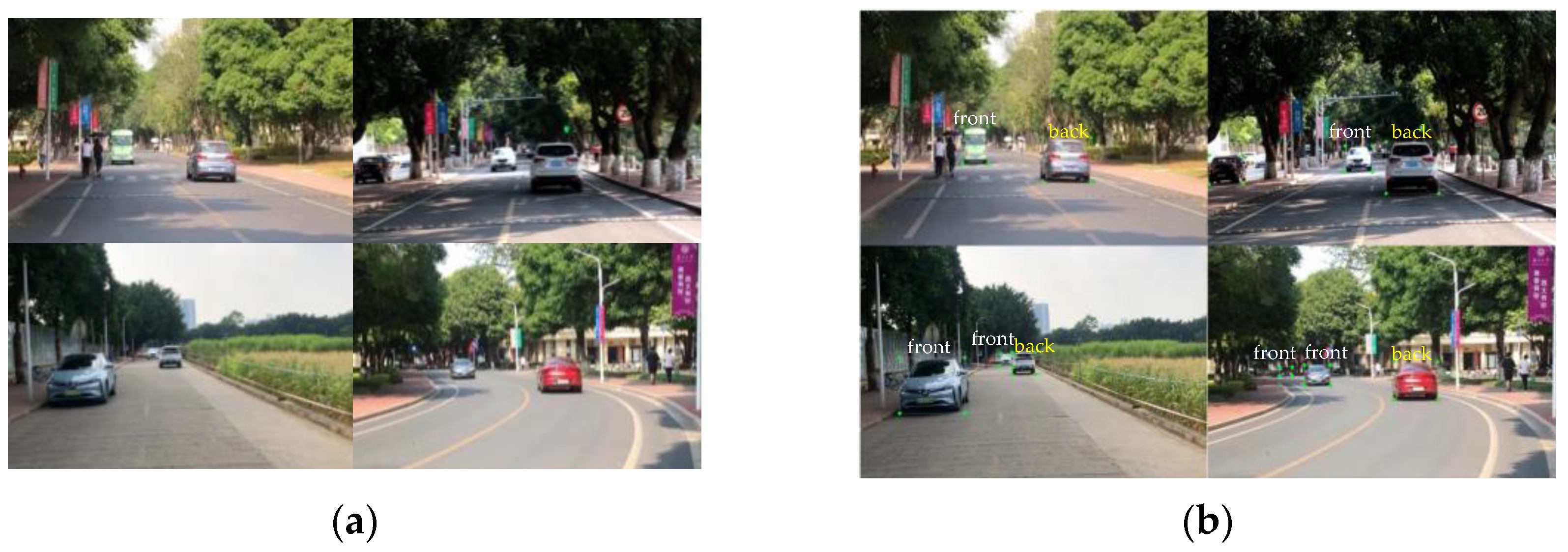
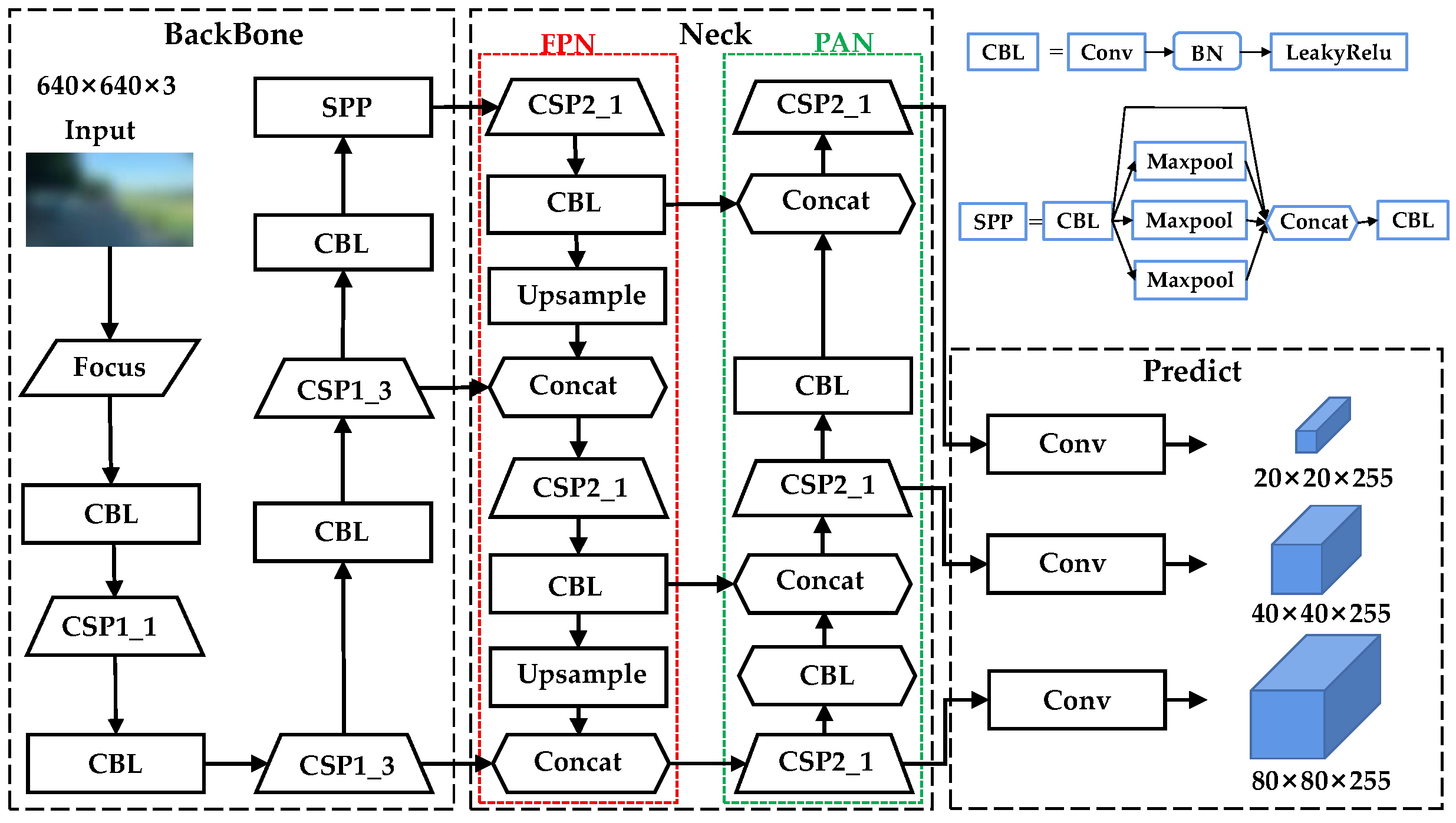
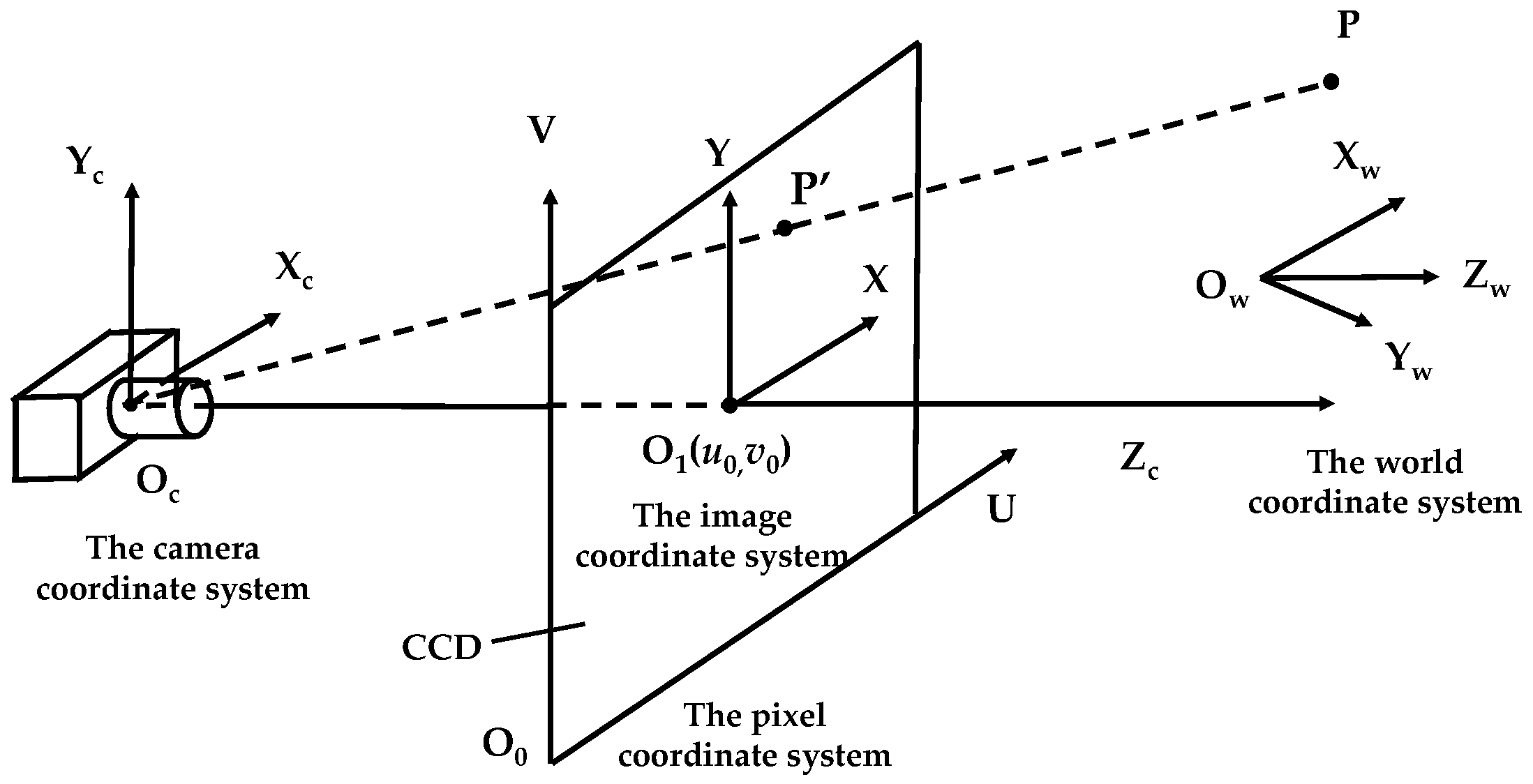
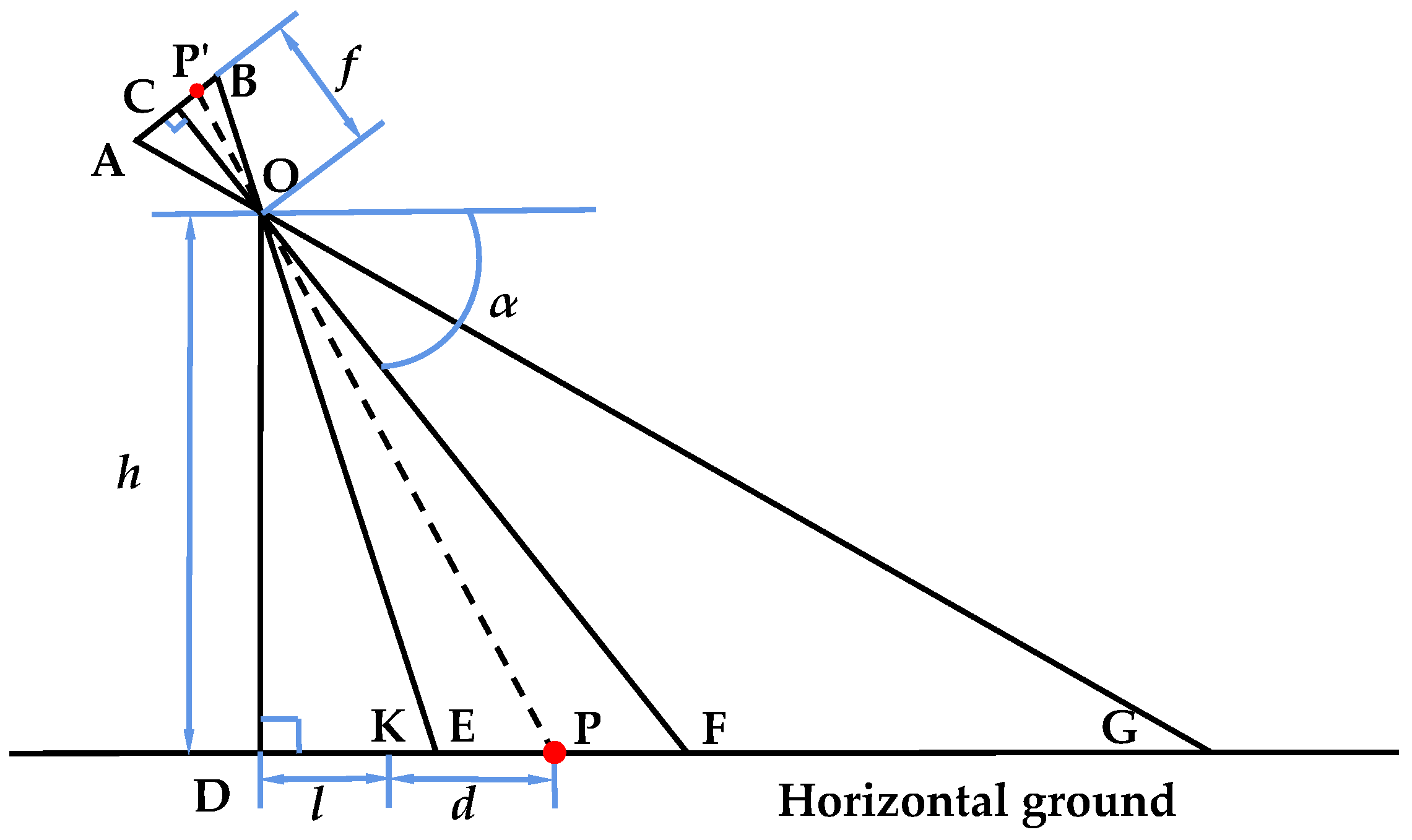
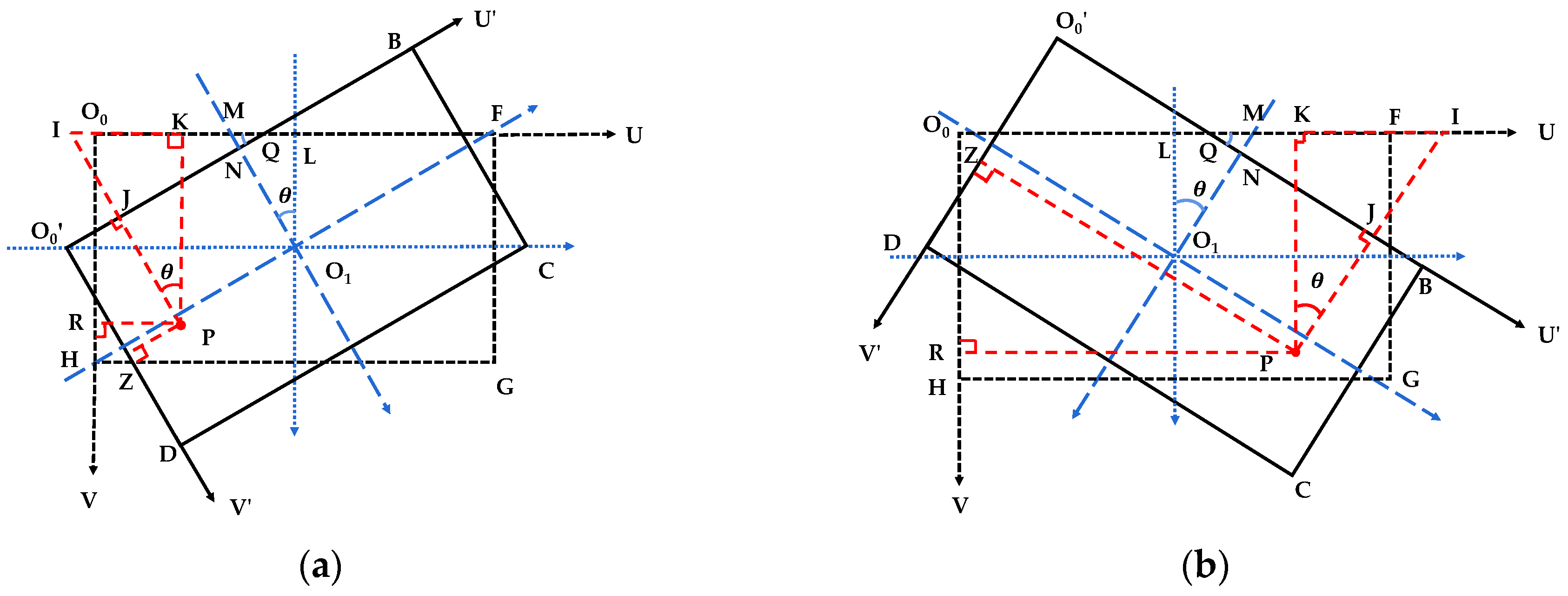
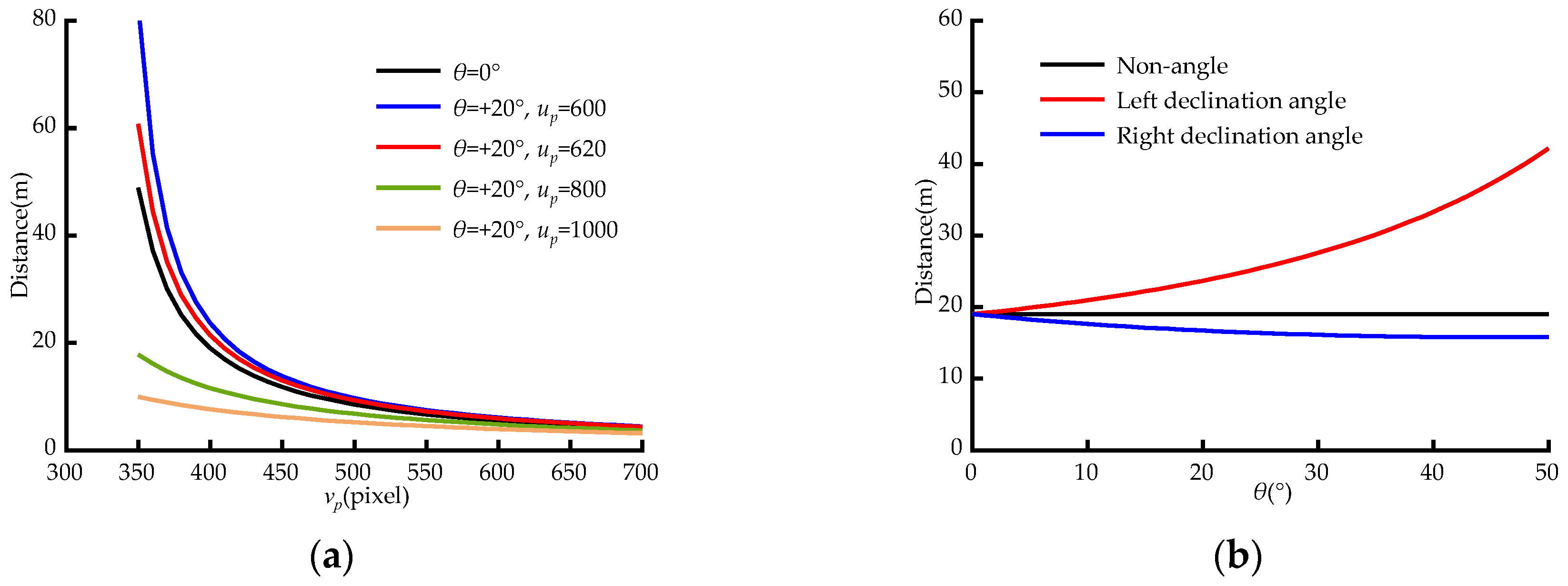

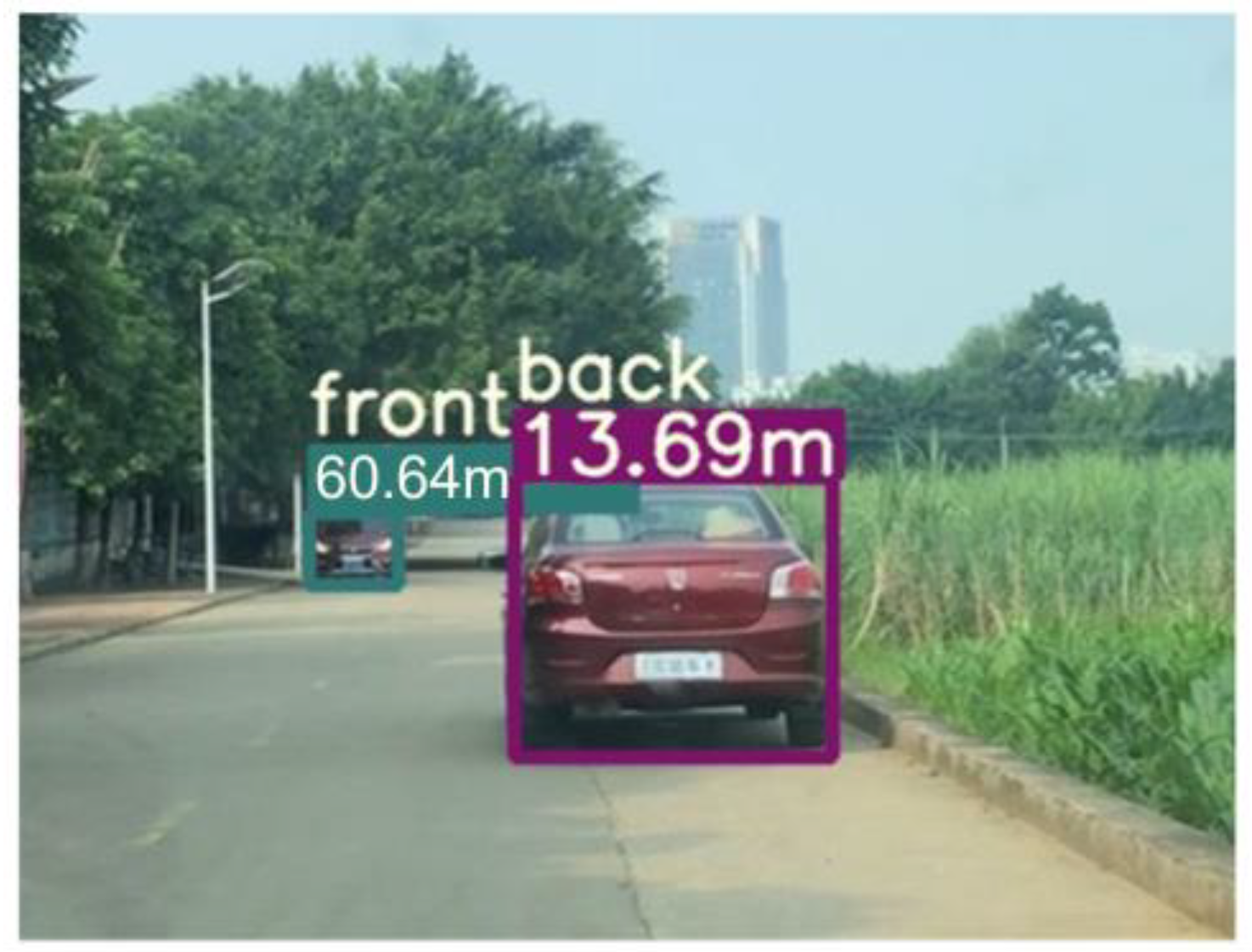
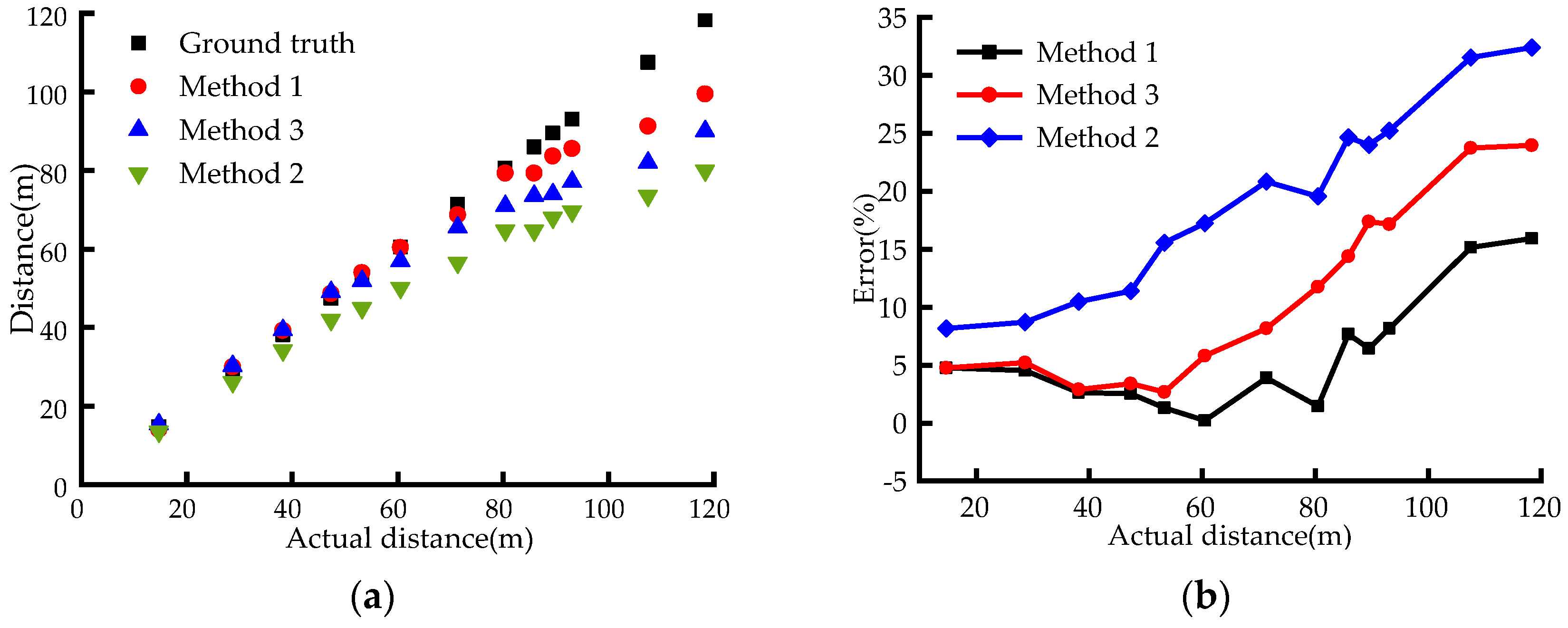
| Relevant Parameters | Global Parameters | Simulation 1 | Simulation 2 | ||||
|---|---|---|---|---|---|---|---|
| h (m) | f (Pixel) | (u0, v0) | Image Size (Pixel) | α (°) | θ (°) | (up, vp) | |
| value | 1.3 | 1200 | (640, 360) | 1280 × 720 | −2 * | +20 * | (600, 400) |
| Vehicle Category | AP | mAP |
|---|---|---|
| back | 0.978 | 0.964 |
| front | 0.951 |
| Parameter | Internal Parameters | External Parameters | |||||
|---|---|---|---|---|---|---|---|
| f (Pixel) | u0 (Pixel) | v0 (Pixel) | Image Size (Pixel) | h (m) | θ (°) | α (°) | |
| value | 1223.3 | 630.1 | 372.3 | 1280 × 720 | 1.18 | −1.27 * | −1.03 * |
| Serial Number | Vehicle Category Detection | Distance Measurement | |||||||
|---|---|---|---|---|---|---|---|---|---|
| Ground Truth | Experimental Results | Ground Truth (m) | Method 3 | Method 2 | Method 1 | ||||
| Experimental Results (m) | Absolute Error (%) | Experimental Results (m) | Absolute Error (%) | Experimental Results (m) | Absolute Error (%) | ||||
| 1 | back | back | 14.7 | 15.4 | 4.76 | 13.5 | 8.16 | 14.0 | 4.76 |
| 2 | back | back | 28.7 | 30.2 | 5.22 | 26.2 | 8.71 | 30.0 | 4.52 |
| 3 | back | back | 38.2 | 39.3 | 2.87 | 34.2 | 10.47 | 39.2 | 2.61 |
| 4 | back | back | 47.4 | 49.0 | 3.41 | 42.0 | 11.39 | 48.6 | 2.53 |
| 5 | back | back | 52.3 | 51.8 | 2.68 | 45.1 | 15.57 | 54.1 | 1.31 |
| 6 | front | front | 60.5 | 57.0 | 5.82 | 50.1 | 17.22 | 60.4 | 0.21 |
| 7 | front | front | 71.3 | 65.5 | 8.15 | 56.5 | 20.83 | 68.6 | 3.88 |
| 8 | front | front | 80.4 | 71.0 | 11.74 | 64.7 | 19.57 | 79.3 | 1.42 |
| 9 | front | front | 85.8 | 73.5 | 14.38 | 64.7 | 24.66 | 79.3 | 7.66 |
| 10 | front | front | 89.4 | 73.9 | 17.40 | 68 | 24.00 | 83.7 | 6.46 |
| 11 | front | front | 93.1 | 77.1 | 17.13 | 69.6 | 25.23 | 85.5 | 8.15 |
| 12 | front | front | 107.5 | 82 | 23.72 | 73.6 | 31.53 | 91.2 | 15.16 |
| 13 | front | front | 118.3 | 90.0 | 23.98 | 80.0 | 32.41 | 99.5 | 15.94 |
Disclaimer/Publisher’s Note: The statements, opinions and data contained in all publications are solely those of the individual author(s) and contributor(s) and not of MDPI and/or the editor(s). MDPI and/or the editor(s) disclaim responsibility for any injury to people or property resulting from any ideas, methods, instructions or products referred to in the content. |
© 2023 by the authors. Licensee MDPI, Basel, Switzerland. This article is an open access article distributed under the terms and conditions of the Creative Commons Attribution (CC BY) license (https://creativecommons.org/licenses/by/4.0/).
Share and Cite
Yang, R.; Yu, S.; Yao, Q.; Huang, J.; Ya, F. Vehicle Distance Measurement Method of Two-Way Two-Lane Roads Based on Monocular Vision. Appl. Sci. 2023, 13, 3468. https://doi.org/10.3390/app13063468
Yang R, Yu S, Yao Q, Huang J, Ya F. Vehicle Distance Measurement Method of Two-Way Two-Lane Roads Based on Monocular Vision. Applied Sciences. 2023; 13(6):3468. https://doi.org/10.3390/app13063468
Chicago/Turabian StyleYang, Rong, Shuyuan Yu, Qihong Yao, Junming Huang, and Fuming Ya. 2023. "Vehicle Distance Measurement Method of Two-Way Two-Lane Roads Based on Monocular Vision" Applied Sciences 13, no. 6: 3468. https://doi.org/10.3390/app13063468
APA StyleYang, R., Yu, S., Yao, Q., Huang, J., & Ya, F. (2023). Vehicle Distance Measurement Method of Two-Way Two-Lane Roads Based on Monocular Vision. Applied Sciences, 13(6), 3468. https://doi.org/10.3390/app13063468





